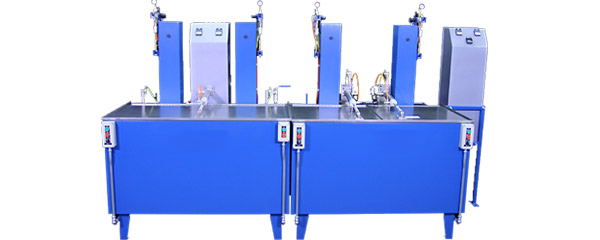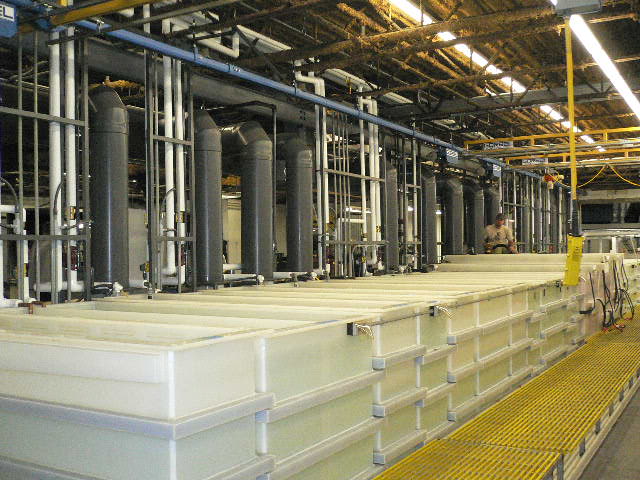Best Technology offers the latest phosphating equipment lines for metal part or weldments used in various applications, including powder coating phosphate wash pre-treatment.
What is the phosphating process and why phosphate parts?
Phosphating or phosphate conversion coating is a manufacturing process and chemical treatment in which an acidic bath solution reacts with the metal part or weldment. It combines with or causes a chemical conversion that transforms the surface of the metal part into a protective layer, which is uniform and inert to the environment. Phosphate coating combinations include zinc phosphate, iron phosphate, chromate, or manganese phosphate.
Benefits of the phosphate treatment include:
- better adhesion for post processes like powder coating paint
- improved corrosion resistance
- surface that is tightly bonded to the base metal.
Phosphating can be performed on ferrous (iron, steel based) and non-ferrous surfaces (zinc, chrome, aluminum, and manganese).
The most common use for phosphating is pretreatment of parts before they enter a powder coating system. Powder coat paint is a dry finishing process that uses finely ground particles of color which are electrostatically charged and sprayed onto electrically opposite charged or grounded parts. Naturally opposite charges attract, so the charged powder particles adhere to the part. The parts are typically placed in a curing oven to melt the powder into a uniform color layer.
Wash and Phosphating Lines
The most important stage of powder coating phosphate wash is properly preparing the parts by cleaning residues left from prior processes like welding, grinding, and drawing residues such as machining oils, grease, dust, and rust and then iron phosphate coating. This is commonly achieved in a multistage alkaline cleaning, rinsing, phosphating, and rinsing immersion tanks or spraying system. Iron phosphate can sometimes combine washing/cleaning with phosphating depending on initial part cleanliness.
4 Stage Agitated Immersion System – Wash, Rinse, Phosphate, Rinse
In some iron phosphate coating applications, the clean and coating are combined; otherwise each stage is typically separated by a rinse stage to remove residual chemistry.
Large Scale Phosphate Coating and Plating Line
Phosphating Process Controls
Controlling the phosphating process is essential to achieving consistent coatings which ultimately result in a stable powder coating process. The most important process controls in phosphate conversion coating are:
- Time – The longer the contact time, the more time to chemically react. The process must be long enough to allow the chemistry to form a uniform coating.
- Temperature – Chemistries typically become more aggressive at elevated temperatures.
- Concentration and pH – The more acid in concentration accelerates the coating process and can result in a heavier total weight of the coating.
Types of Phosphating Lines
Iron Phosphate Coating
Iron phosphate treatment is the most common pretreatment for powder coating because it can be used with almost any material and has more environmentally friendly by-products or sludge. This process is commonly used on steel materials.
Zinc Phosphate Coating
Zinc phosphate is a non-metallic, crystalline coating that is extremely adherent to materials. It is important to note that the zinc phosphate coating results from the solution itself, not from the part surface like an iron phosphate coating. Zinc phosphate crystals start forming at anodic surfaces on the part surface and stop forming when the part surface area is consumed, ie. they hit another crystal.
Unlike iron phosphate, zinc phosphate cannot clean and coat at the same time; therefore, a four-stage wash, rinse, zinc phosphate, rinse is a common setup. While zinc phosphating provides improved coating adhesion properties, better coating in tight areas and better corrosion resistance, the process has higher operating costs, uses heavy metals, and can produce considerable sludge, none of which is environmentally friendly for disposal purposes. Zinc phosphate is typically used on galvanized steel materials.
Chromium Phosphate Coating
Chromium phosphate is most commonly used for aluminum alloy based parts. While this process is effective, like zinc phosphate, it uses heavy metals which need to be recovered for environmentally friendly disposal.
Fortunately more environmentally friendly alternatives are becoming available for use with aluminum and aluminum alloys. For more details, please see our article on What is Chromate Conversion Coating?
Best Technology’s phosphating lines provide for excellent phosphate treatment of parts before post processing like powder coat paint. To learn more, contact an expert in phosphate treatment and parts cleaning and receive a free proposal for your project.


